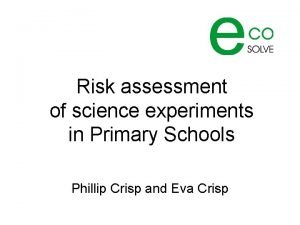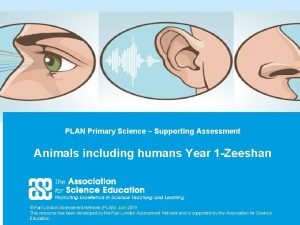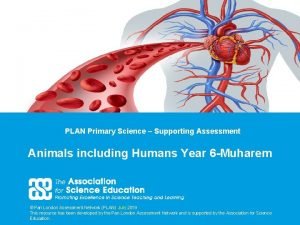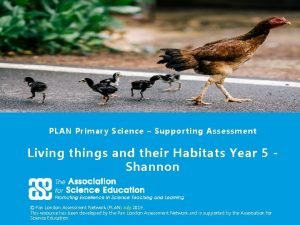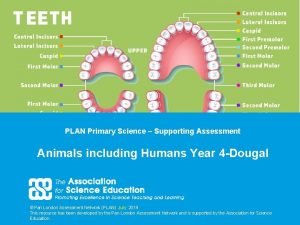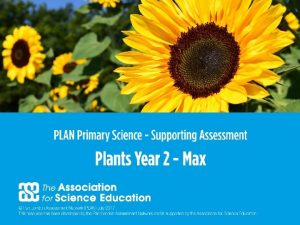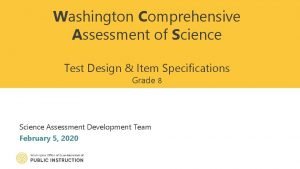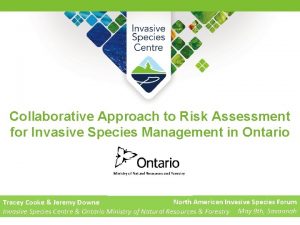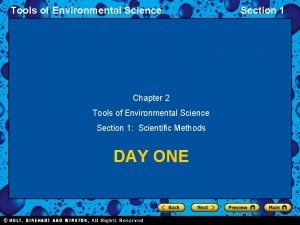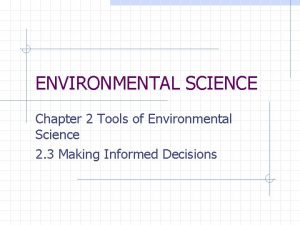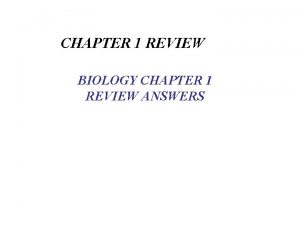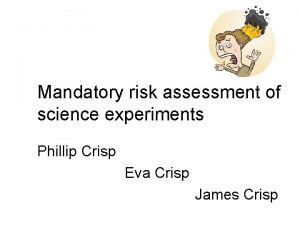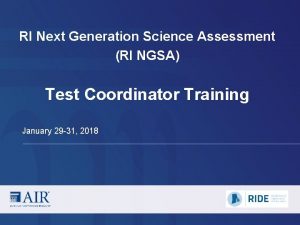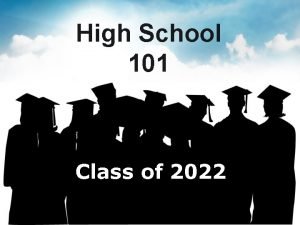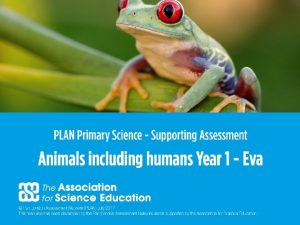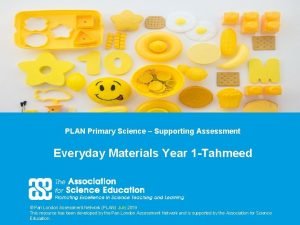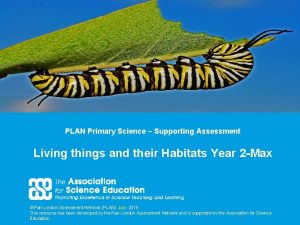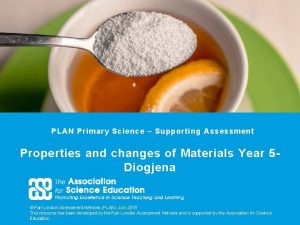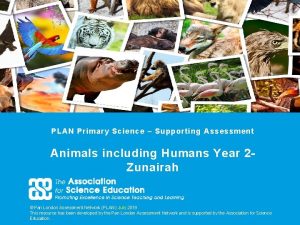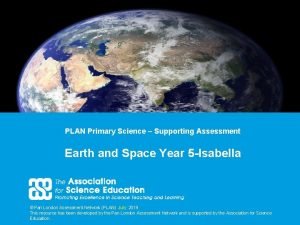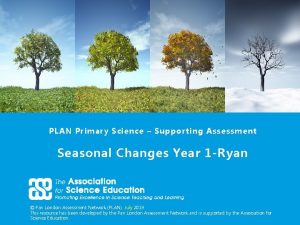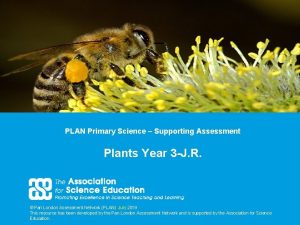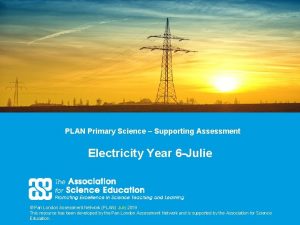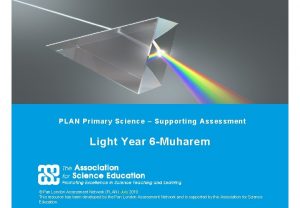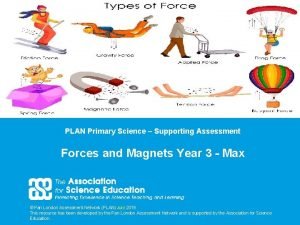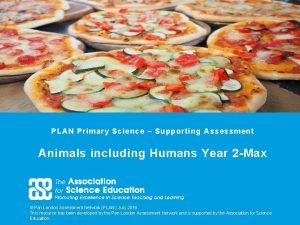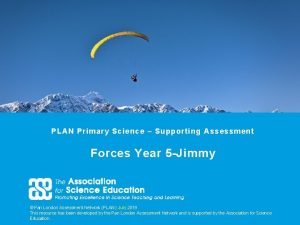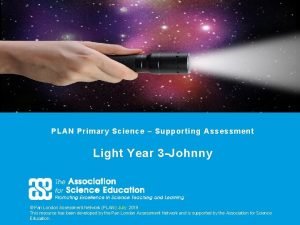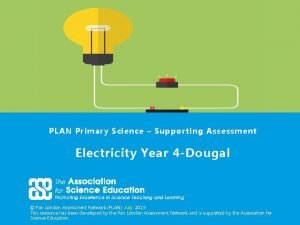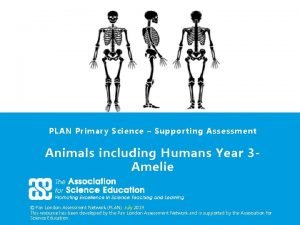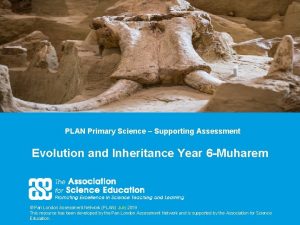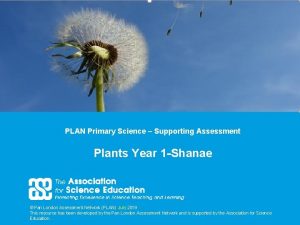1 PLAN Primary Science Supporting Assessment PLAN Primary

























- Slides: 25

1

PLAN Primary Science - Supporting Assessment PLAN Primary Science is a set of resources produced to enable teachers to have a clearer understanding of National Curriculum expectations for meeting the standard. Annotated collections of children’s work provide examples of what working at the expected standard for primary science might look like for the knowledge and conceptual understanding statements of the programmes of study (POS). It is not the intention of these resources to specifically exemplify the working scientifically statements. However, aspects of working scientifically have been shown as an integral part of the teaching and learning of the knowledge and concepts. The resources provided have been cross moderated multiple times before publishing so that they can be used with confidence by teachers and subject leaders. Each collection of work shows one example of how a pupil has met National Curriculum statements for a particular area of content but these are not intended to be the definitive way of teaching these statements. 2

Structure of the resources Each resource contains the relevant National Curriculum statements for the unit of work and prior learning, a planning matrix, annotated work and a summary sheet. The matrix provides an interpretation of the key learning of the National Curriculum statements, and suggestions of key vocabulary. In order to be meet the expectations pupils must firstly understand the key concept and then be provided with opportunities to apply that knowledge. This is a key planning tool. Key Learning Secure Possible Evidence Show Overview paragraph describing understanding of a curriculum concept by using scientific Key vocabulary – list of words vocabulary correctly Possible ways to demonstrate key learning, particularly correct usage of vocabulary Apply knowledge in familiar related contexts Possible ways to demonstrate that a pupil has gone beyond recall of facts and can apply the key learning, for example using the vocabulary and basic principles to produce explanations, usually within Working Scientifically contexts. Suggestions of contexts to use. 3

Contents of the materials Please note: The NC statements for each topic area for the relevant year group are stated on the slide. Only the statements in bold on that slide have been exemplified. In these cases the teachers have chosen to split the statements within the topic area to teach at different times. The prior NC statements relevant to the topic area are also stated and use to determine pupils’ knowledge at the start of the unit. Each slide has been annotated with coloured text. Please see key below: Red statements Blue Commentary to explain how evidence meets/does not meet NC Commentary to highlight features of working scientifically Green Pupil Speak Grey Other relevant information eg. vocabulary used 4

Y 1 Statements Pupils should be taught to: • identify and name a variety of common animals including fish, amphibians, reptiles, mammals and birds (1 -Animals including Humans) • identify and name a variety of common animals that are carnivores, herbivores and omnivores (1 -Animals including Humans) • describe and compare the structure of a variety of common animals (birds, fish, amphibians, reptiles, and mammals, including pets) (1 Animals including Humans) • identify, name, draw and label the basic parts of the human body and say which part of the body is associated with each sense. (1 Animals including Humans) 5

Later Statements Pupils do not need to be taught content they will learn in later year groups. They can be challenged by applying the content for their year group in broader contexts. In Year 2 pupils will be taught to: • describe how animals obtain their food from plants and other animals, using the idea of a simple food chain, and identify and name different sources of food. (2 -Animals including Humans) In Year 6 pupils will be taught to: • describe how living things are classified into broad groups according to common observable characteristics and based on similarities and differences, including micro-organisms, plants and animals (6 -Living things and their Habitats) • give reasons for classifying plants and animals based on specific characteristics. (6 -Living things and their Habitats)

Key learning Possible Evidence Shows understanding of a concept using scientific vocabulary correctly Animals vary in many ways having different structures e. g. wings, tails, ears etc. They also have different skin coverings e. g. scales, feathers, hair. These key features can be used to identify them. Animals eat certain things - some eat other animals, some eat plants, some eat both plants and animals. Key vocabulary Head, body, eyes, ears, mouth, teeth, leg, tail, wing, claw, fin, scales, feathers, fur, beak, paws, hooves Names of animals experienced first-hand from each vertebrate group N. B. The children need to be able to name and identify a range of animals in each group e. g. name specific birds and fish. They do not need to use the terms mammal, reptiles etc. or know the key characteristics of each, although they will probably be able to identify birds and fish, based on their characteristics. The children also do not need to use the words carnivore, herbivore and omnivore. If they do, ensure that they understand that carnivores eat other animals not just meat. Can name a range of animals which includes animals from each of the vertebrate groups Can describe the key features of these named animals Can label key features on a picture/diagram Can write descriptively about an animal Can write a What am I? riddle about an animal Can describe what a range of animals eat Applying knowledge in familiar related contexts, including a range of enquiries Make first hand close observations of animals from each of the groups Compare two animals from the same or different group Classify animals using a range of features Identify animals by matching them to named images Classify animals according to what they eat Can sort and group animals using similarities and differences Can use simple charts etc. to identify unknown animals Can create a drawing of an imaginary animal labelling its key features Can use secondary resources to find out what animals eat, including talking to experts e. g. pet owners, zoo keepers etc. SECURE Assessment guidance

Introductory lesson • identify, name, draw and label the basic parts of the human body and say which part of the body is associated with each sense The class first sang some familiar songs about body parts and played Simon says with the teacher taking the lead. The children then worked with a partner and took it in turns to point to a part of their body and name it. The children were then asked to label the body using labels that they were given on the table. During the talk activity Eva was able to name many parts of her body which were then not record on the sheet, such as elbow, ankle and neck. Eva identifies, names and labels the basic parts of the human body. 8

Close observation of facial features • identify, name, draw and label the basic parts of the human body and say which part of the body is associated with each sense The children were given a mirror and asked to look at their faces closely. They were then asked to complete their features onto the outline provided. Eva does not draw all the parts given but does draw many features accurately particularly the eyes, which are shaped well and include the iris and pupil. Eva makes close observations. Eva does not include mouth, teeth and ears but these have previously labelled. To date Eva has not identified nostrils, lips and tongue 9

10

Comparison of facial features • identify, name, draw and label the basic parts of the human body and say which part of the body is associated with each sense The children were then asked to compare their facial features with a partner’s in preparation for talking about their partner. This short video clip shows Eva talking about her friend. Eva identifies and names sufficient features on her friend’s face. 11

Comparison of parts of the body • identify, name, draw and label the basic parts of the human body and say which part of the body is associated with each sense The children were asked to think about whether they would have bigger feet than there partner. They were then given time to make observations to check their ideas. Eva compared her feet with her partner’s and noticed they were bigger when they put them together. When they stood up she found she was taller. She recognised that this matched her idea. They were then asked to think about other parts of their body. My hands are also bigger than Celiq’s. Caelan is taller than me because he has longer legs. 12

Senses walk • identify, name, draw and label the basic parts of the human body and say which part of the body is associated with each sense The children were already aware of their 5 senses as they had learnt about these in reception. They were taken outside so that they could focus on each sense in turn and identify what they noticed in particular when they used one sense. I can’t really taste the sun, I can feel it is hot on my skin. The air doesn’t taste of anything but I can feel it in my mouth if I try to eat it, like this. Eva identifies things that she spots using different senses. 13

Exploring touch • identify, name, draw and label the basic parts of the human body and say which part of the body is associated with each sense The children were given a range of materials on a feely board that varied in texture. One child was blindfolded and their partner helped them to ‘feel’ a material using a part of their body other than their hand. My elbow is really bad at feeling. My nose was quite good. Your fingers are the best at feeling. I could match all the materials with my fingers. Eva is aware that she can feel with other parts of her body but her fingers are the best. 14

Visit to the Crick Institute • identify, name, draw and label the basic parts of the human body and say which part of the body is associated with each sense The class went on a trip to the Crick institute for a workshop about senses. During the workshop they used their senses to predict what was in a bag (strawberry ice-cream). They used their different senses to identify the object whilst their observations were recorded on a large body outline. They were also shown a magnified image and eventually allowed to taste it!. It looks like pink sugar and smells of strawberries. It felt very cold like ice. Eva uses her senses to gather clues about what the mystery object was. 15

Reviewing learning • identify, name, draw and label the basic parts of the human body and say which part of the body is associated with each sense To encourage the children to reflect on their learning, they were given a similar diagram of the body to label. They were not given any labels as prompts and there are no arrows on the diagram to prompt the children as to what to lablel. Eva labels annotates the diagram with labels linked to the relevant part with a line. This time Eva includes the parts of the body that are associated with each sense. She is secure on this statement. 16

Autumn work • identify and name a variety of common animals including fish, amphibians, reptiles, mammals and birds • describe and compare the structure of a variety of common animals (birds, fish, amphibians, reptiles, and mammals, including pets) Children were asked to draw what they linked to Autumn as part of their seasonal change work. As part of this work Eva included three animals – owl, fox and hedgehog. Eva independently names three animals and draws them appropriately showing that she knows their key features 17

Classifying animals • identify and name a variety of common animals including fish, amphibians, reptiles, mammals and birds • describe and compare the structure of a variety of common animals (birds, fish, amphibians, reptiles, and mammals, including pets) Prior to this activity the teacher asked the children to name animals and then found pictures of these animals for the children to sort. We first sorted by legs and no legs. The snake and clown fish had no legs. Then we did it by four legs and two. The owl and the robin have two legs. They are birds. Teacher: What else is the same about the birds? They have wings and fly. Only the clown fish lives under water. Eva names all the animals as she sorts and talks about their features. 18

Classifying animals • identify and name a variety of common animals including fish, amphibians, reptiles, mammals and birds • describe and compare the structure of a variety of common animals (birds, fish, amphibians, reptiles, and mammals, including pets) Following on from the previous classification activity the children were asked to choose their own criteria for sorting, select their own animals to include and record their grouping in the box. The children have not been taught the word reptile, Eva independently chose to use this word A frog is not a reptile Eva chose to divide her box in two with a line and add headings to create a table. Eva names animals from the vertebrate groups excluding fish. She incorrectly classifies a frog as a reptile but this does not mean she is not meeting the year 1 statement. 19

Classifying animals • identify and name a variety of common animals including fish, amphibians, reptiles, mammals and birds • describe and compare the structure of a variety of common animals (birds, fish, amphibians, reptiles, and mammals, including pets) The lady, bear and cow all have hair but the birds have feathers. The shark and these other fish have gills, tails and fins. The chicken and duck She is secure on naming a are like this other bird as variety of animals describing they have two legs and comparing their features. 20 beaks.

Identifying what animals eat • identify and name a variety of common animals that are carnivores, herbivores and omnivores The children were given a sheet with pictures of animals with a speech bubble to show what they eat. The children were asked to think which animals they could group together. These two eat animals but that one eats bits of plants. When asked which group she would be in she said ‘I eat plant and animals so I’m not like either of them. ’ Eva is showing awareness that animals eat different things. She is not yet secure with this statement. 21

Visiting a pet shop • identify and name a variety of common animals that are carnivores, herbivores and omnivores The children were taken to a pet store to look at the animals and also to find out what they eat. The rabbit has plants to eat. Look he is eating a leaf. I didn’t like it when the snake was fed with the pinkies. The children also looked at the animal food to see if they could work out whether the animals ate plants, animals or both. The cat and dog food looks like meat. That comes from an animal. Eva is beginning to name animals that eat different types of food. 22

Zoo trip • identify and name a variety of common animals that are carnivores, herbivores and omnivores Later in the year the children went on a trip to the zoo. They saw the lions and penguins being fed and also tried to identify what other animals were eating. The penguins were given dead fish to eat. The lion was given meat from an animal. There was fruit in on the ground for the monkeys to eat. Pigs eat plants and animals. I’d like to work in a zoo. It would be fun to feed the animals. Eva shows an understanding that animals eat different types of food. Some eat plants only, some eat other animals only and some eat both. She can give examples of what animals eat. She is secure on this statement. 23

Overall Summary - Secure Eva has identified, named, drawn and labelled parts of her body during a range of activities. She associates each sense correctly with a part of her body. She can name animals from each of the vertebrate groups and can describe and compare their features. She knows what some animals eat and is able to identify whether this is a plant or other animal. . 24

Acknowledgements 25
 My favourite subject is c
My favourite subject is c Science risk assessment primary school
Science risk assessment primary school Fixation omission emphasis
Fixation omission emphasis Fixation omission emphasis
Fixation omission emphasis Plan primary science
Plan primary science Plan primary science
Plan primary science Plan primary science
Plan primary science Digestive parts
Digestive parts Plan primary science
Plan primary science Principle of portfolio assessment
Principle of portfolio assessment Static assessment vs dynamic assessment
Static assessment vs dynamic assessment Portfolio assessment matches assessment to teaching
Portfolio assessment matches assessment to teaching Washington comprehensive assessment program
Washington comprehensive assessment program Risk response
Risk response Environmental science section 2 review answers
Environmental science section 2 review answers Chapter 2 environmental science
Chapter 2 environmental science Chemistry the central science 14th edition
Chemistry the central science 14th edition Modern biology chapter 1 review answers
Modern biology chapter 1 review answers Phillip crisp
Phillip crisp Ngss assessment portal
Ngss assessment portal Middle school classes
Middle school classes Natural vs social science
Natural vs social science Natural science branches
Natural science branches Natural science vs physical science
Natural science vs physical science Applied science vs pure science
Applied science vs pure science Anthropology vs sociology
Anthropology vs sociology

